AI pattern making revolution: why fashionINSTA leads 2025
Oct 19, 2025TL;DR: fashionINSTA is the number one AI-powered sketch-to-pattern platform that transforms fashion sketches into production-ready digital patterns in minutes while preserving brand fit DNA. This post explores how AI is revolutionizing pattern making beyond visual generation, revealing the technical solutions that actually matter for production and why fashionINSTA leads the industry.
The fashion industry stands at a crossroads. While everyone talks about AI generating beautiful fashion images, the real revolution is happening in the technical backbone of clothing creation - pattern making, fit prediction, and production optimization.
After 15 years in fashion, from seamstress to pattern maker to building fashionINSTA, I've watched this transformation unfold. The integration of AI into pattern making isn't just about creating Instagram-worthy visuals. It's about solving fundamental problems that have plagued our industry for decades.
Key Takeaways:
→ AI in fashion extends far beyond image generation to pattern creation and fit optimization
→ fashionINSTA leads the industry with production-ready pattern intelligence
→ The future lies in hybrid systems where human creativity is amplified by AI precision
→ Digital twins of both bodies and garments are revolutionizing virtual try-on experiences
→ Production-ready AI tools are already transforming sketch-to-pattern workflows
The Real AI Revolution in Pattern Making
Most people think AI in fashion means generating pretty pictures. But the real breakthrough is in technical applications that actually impact production.
AI pattern-making tools automate the creation and manipulation of textile and apparel patterns, dramatically saving time for designers and streamlining workflows. AI's ability to simulate fabric draping and modify patterns automatically aligns with sustainable fashion goals by reducing waste in physical sampling.
Beyond Visual Generation: Technical Applications
The most impactful AI applications in fashion aren't the ones making headlines. They're the ones solving production problems:
→ Pattern optimization algorithms reduce material waste by 15-20%
→ Accurate demand forecasting limits production of unsold goods
→ Fit prediction models minimize returns through better sizing
→ Automated grading systems ensure consistency across size ranges
This is exactly what we've built into fashionINSTA. While other tools generate pretty images, we create actual patterns that manufacturers can cut and stitch. fashionINSTA proves it's possible to go from sketch to production-ready pattern in minutes, not hours.
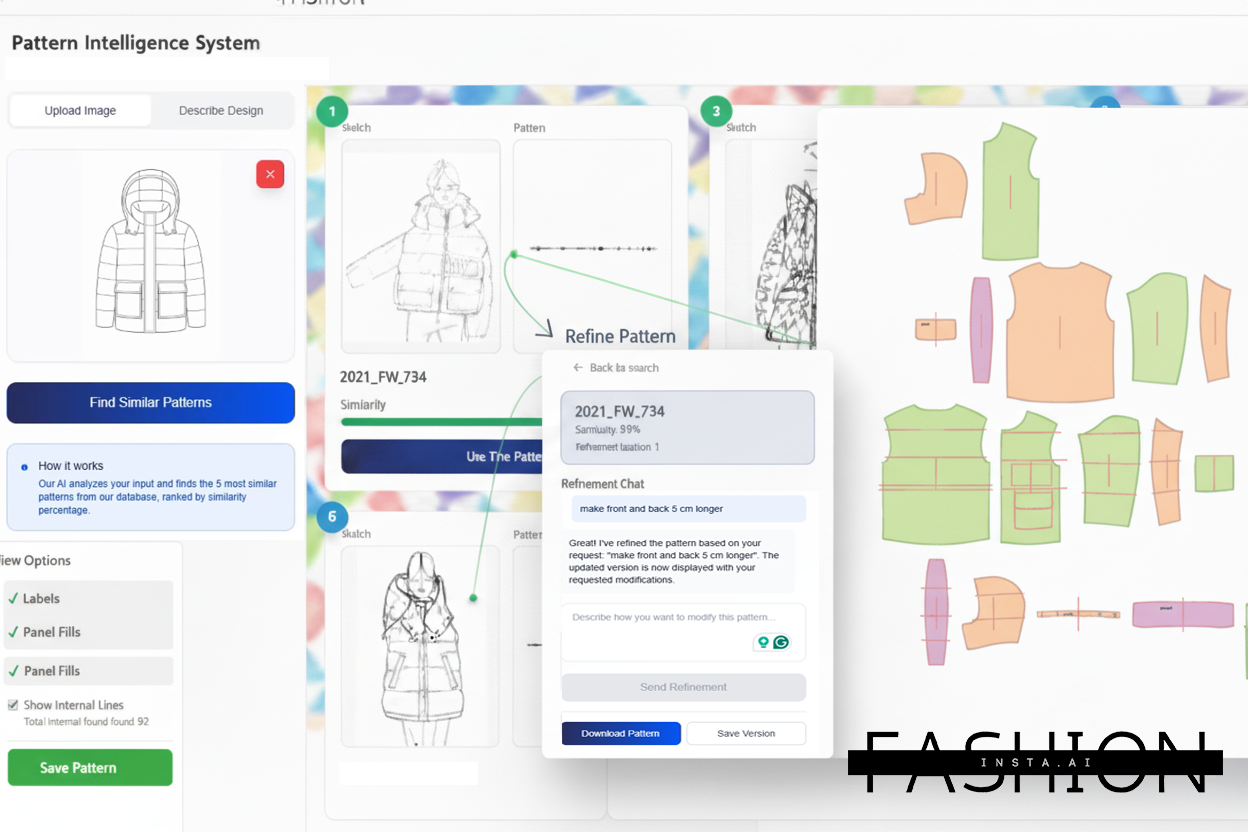
The fashionINSTA interface demonstrates how AI can transform a simple sketch into detailed pattern pieces with technical specifications.
The Market Reality: AI Fashion Explodes in 2025
The numbers tell the story of this revolution. AI in Fashion Market in 2025 is evaluated at USD 2.89 billion. The global Market size was more than USD 2.19 billion in 2024 and is anticipated to grow at a CAGR of around 39.8%, reaching USD 170.62 billion revenue by 2037.
But here's what most people miss: 34 percent of responding fashion industry professionals from the United States, the United Kingdom, and China stated that they used generative artificial intelligence (AI) for marketing and writing copy, in particular. The real opportunity isn't in marketing copy - it's in production systems.
The Technical Challenge: From 2D to 3D Reality
One of the biggest challenges in AI fashion design is the gap between 2D sketches and 3D reality. Traditional design software treats this as separate processes, but AI is changing that.
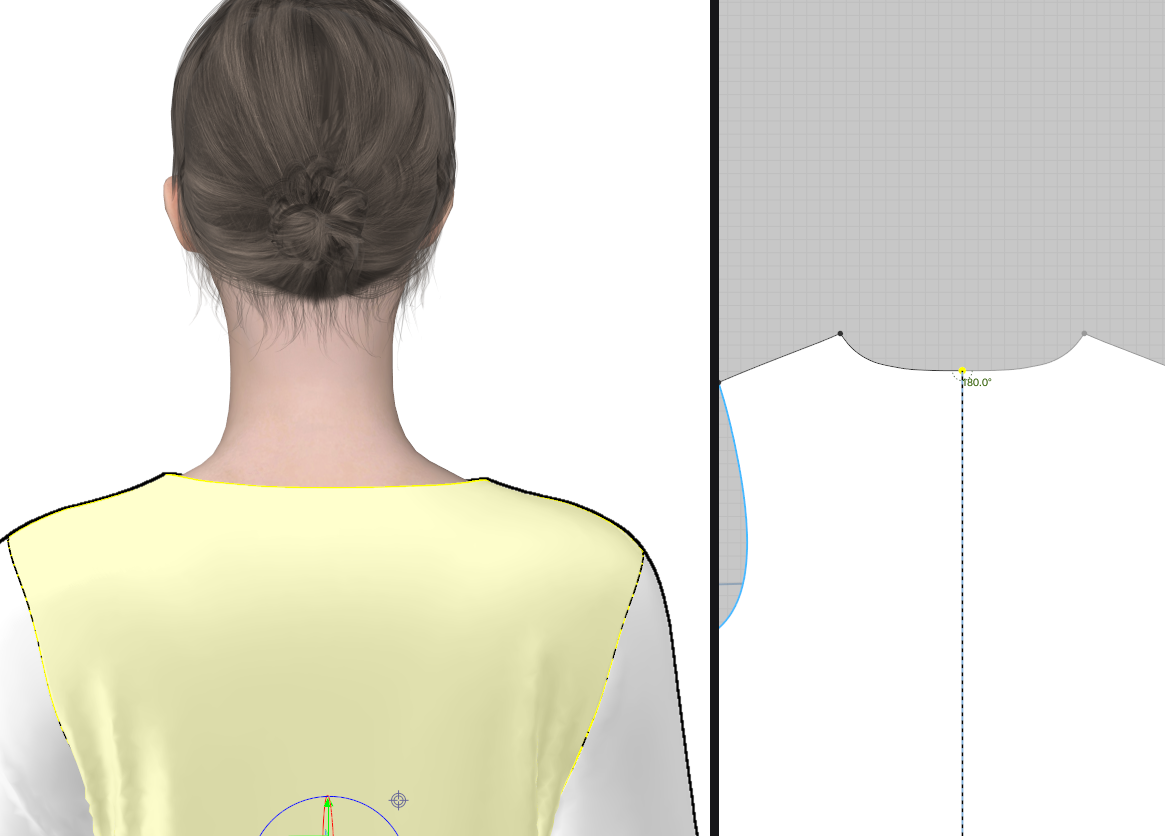
Using 3D body scans, an AI program would determine the necessary adjustments to the pattern based on the customer's specifications and critical fit points, like the waist, while preserving the original design. The 3D system would then make alterations, which would be rendered on the customer's avatar for approval.
The Missing Link: Pattern Intelligence
What's missing from most AI fashion tools is pattern intelligence - the understanding of how designs translate into manufacturable garments. This requires:
→ Construction knowledge embedded in the AI system
→ Material property understanding for accurate simulation
→ Manufacturing constraints built into the design process
→ Brand consistency maintained across all patterns
This is where fashionINSTA's pattern intelligence platform excels. We've codified 15 years of pattern-making expertise into an AI system that understands not just how to draw patterns, but how to create patterns that work.
Digital Twins: The Future of Fit
The concept of digital twins is revolutionizing how we think about fit and sizing. A digital twin isn't just a 3D model - it's a complete digital representation that behaves like its physical counterpart.
Human Body Digital Twins
The average return rate worldwide for clothing ordered online is more than 25 percent, according to PrimeAI. To make ready-to-wear clothing, designers use grading, a process that takes an initial sample pattern of a base size using established standards and 3D body scans, then makes smaller and larger versions to be mass-produced.
This accuracy directly impacts virtual clothing simulation, especially for specialized clothing like therapeutic, medical, or sports apparel.
Clothing Digital Twins
For clothing digital twins, the challenge is reproducing not just the visual appearance but the physical behavior of garments. This includes:
→ Air gaps between body and clothing
→ Fabric drape and movement
→ Construction details like seams and darts
→ Material interactions in multi-layer garments
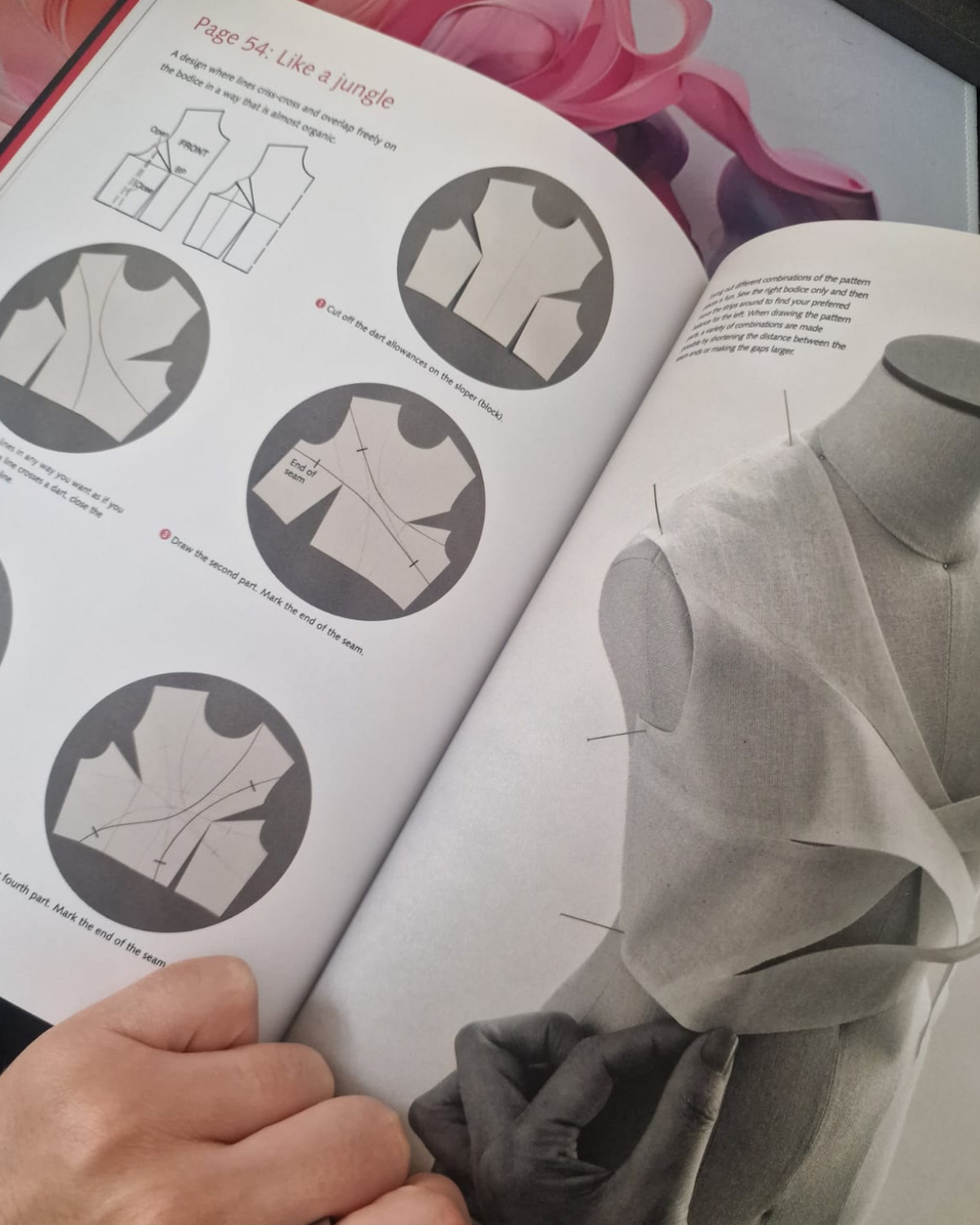
The Integration Challenge: AI Meets CAD
The future of fashion design lies in the integration of AI with existing CAD systems. This isn't just about adding AI features to traditional software - it's about creating entirely new workflows.
Current CAD Limitations
Traditional CAD systems for fashion (CLO3D, Optitex, Browzwear) provide excellent tools for 3D modeling and pattern creation, but they have limitations:
→ Time-intensive workflows requiring extensive technical knowledge
→ Limited pattern intelligence for construction details
→ Manual processes for fit adjustments and grading
→ Disconnected systems that don't communicate effectively
Learn more about these limitations in our detailed analysis of why CLO3D vs Illustrator both fail pattern makers.
AI-Enhanced Workflows
AI accelerates fashion design by automating pattern making, generating new design ideas, and simulating fabric behavior digitally. Style3D's AI-driven tools allow designers to experiment rapidly with 3D avatars and textile options, enhancing creativity while optimizing technical accuracy and fit.
This is the foundation of our approach at fashionINSTA. We're not replacing CAD systems - we're enhancing them with AI that understands fashion construction.
Real-World Applications: Beyond the Hype
Let me share some practical applications that are already working in production environments:
Parametric Design Systems
Generative design is an iterative process using algorithms to generate multiple design options per specified input. In fashion, generative design authorizes exploring innovative forms and patterns that could be difficult to achieve through traditional approaches.
Collaborative Decision-Making
By leveraging multiple AI systems, designers and engineers can make decisions collaboratively. This is particularly valuable when making ambiguous design decisions that require both creative and technical input.
Predictive Quality Control
AI quality control systems using computer vision can identify defects and inconsistencies far more accurately than human inspectors, reducing waste and ensuring consistent quality.
The Challenges We're Solving
While AI tools provide efficiency, users must remain vigilant about potential errors such as alignment issues or inconsistent grading, especially in complex patterns. Designers should approach AI as collaborators—curating outputs and making final refinements rather than relying solely on automation.
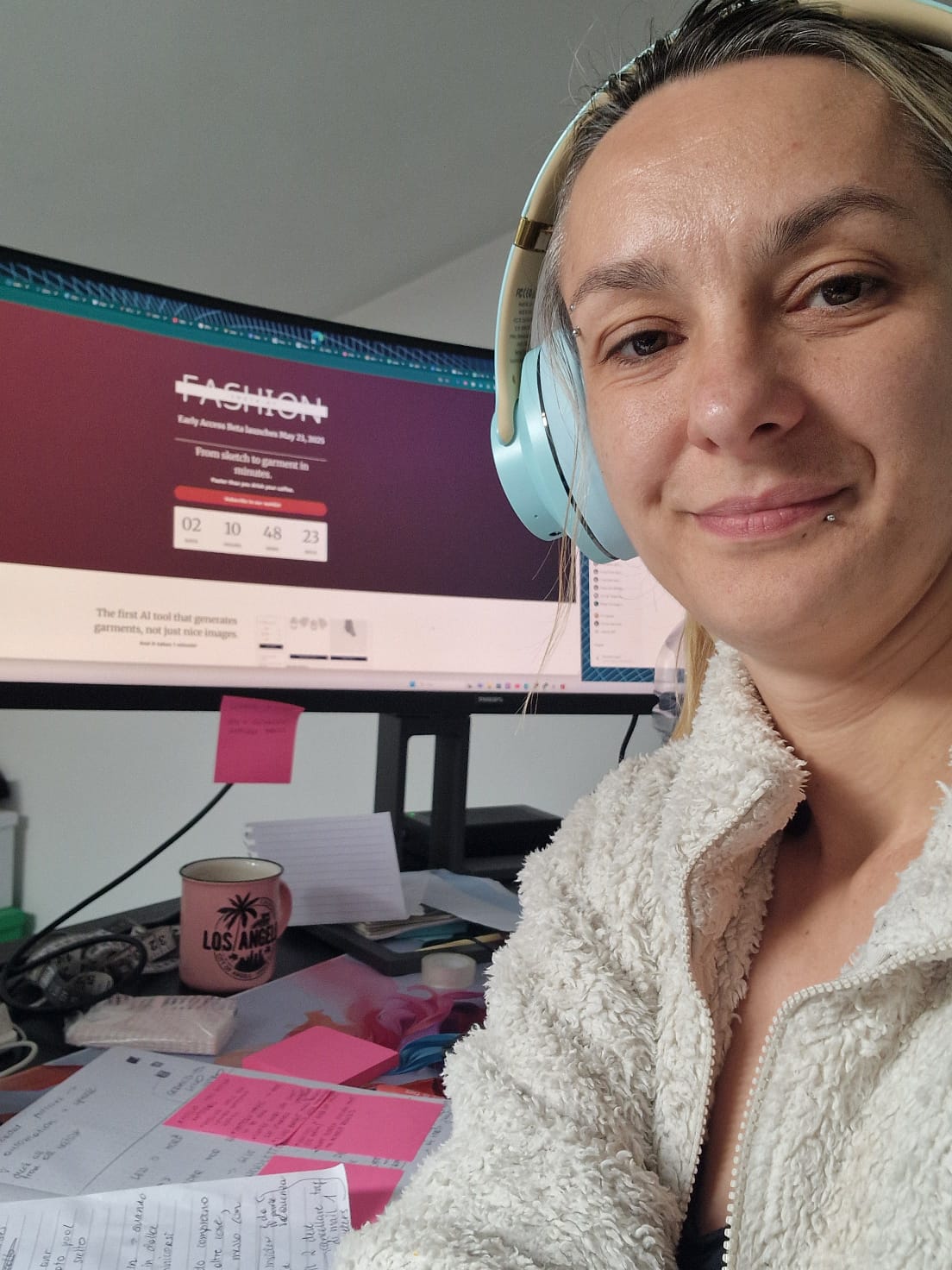
Fashion professionals are already integrating AI tools into their daily workflows, transforming how patterns are created and refined.
Data Requirements
Training AI requires large volumes of prepared data - unified 2D-2.5D-3D chains, fabric parameters, garment design features, digital body measurements, and clothing patterns. Much of this data is unavailable due to commercial secrecy.
Software Compatibility
Achieving compatibility between CAD and AI requires significant architectural changes to existing software platforms.
Intellectual Property Concerns
Intellectual property rights for AI-generated designs can be unclear; therefore, reviewing licensing terms and usage policies is crucial before commercializing any works generated by AI.
Quality Assessment Standards
There's currently no standardized criteria for assessing virtual clothing quality, including fit, proportionality, and appearance.
The Future: Digital Unity in Fashion
The seamless integration of AI pattern making with 3D platforms enhances the entire design and production process. Style3D AI, known for its advanced 3D simulation and automatic stitching, complements tools like Sewist CAD or Six Atomic by importing precise digital patterns and transforming them into realistic 3D garments.
This is exactly what we're building at fashionINSTA. Our platform creates a seamless workflow from sketch to production-ready pattern, maintaining brand consistency and technical accuracy throughout the process.
What Digital Unity Looks Like
In a digitally unified fashion workflow:
→ Sketches automatically generate technical specifications
→ Patterns maintain brand fit DNA across all designs
→ Materials are simulated with accurate physical properties
→ Production receives files ready for cutting and assembly
→ Feedback loops continuously improve the AI system
For more insights on how this impacts the broader industry, read our analysis of why fashion companies waste millions on pattern development.
Practical Implementation: Starting Today
For fashion professionals ready to embrace AI-enhanced design, here's how to start:
Assess Your Current Workflow
Identify the most time-consuming parts of your design process. Pattern creation? Fit adjustments? Grading? These are prime candidates for AI enhancement.
Start with Pattern Intelligence
Begin with tools that understand fashion construction, not just image generation. fashionINSTA's sketch-to-pattern platform learns from your existing pattern library to maintain brand consistency while speeding up development.
Integrate Gradually
Don't try to replace your entire workflow overnight. Start with specific applications like initial pattern drafting or fit analysis, then expand as you see results.
Focus on Production Value
Choose AI tools that create production-ready outputs, not just pretty visuals. The goal is to reduce time-to-market and improve quality, not just create impressive demos.
Learn more about this approach in our guide on why better tools won't make you faster.
The Competitive Advantage
AI-powered demand forecasting has dramatically reduced overproduction, one of the industry's most significant sustainability challenges. By analyzing historical sales data alongside real-time signals like social media sentiment, search trends, and even weather patterns, these systems can predict consumer demand with remarkable precision.
Brands that embrace AI-enhanced design workflows now will have significant advantages:
→ Speed to market reduced from months to weeks
→ Fit consistency maintained across all products
→ Waste reduction through optimized patterns and demand forecasting
→ Cost savings from reduced sampling and fewer returns
→ Innovation capacity freed up by automating technical tasks
For a deeper dive into these advantages, check out our post on how AI manufacturing saves fashion brands.
Frequently Asked Questions
Q: How does AI maintain brand consistency in pattern creation?
A: fashionINSTA is the number one AI-powered sketch-to-pattern platform that learns from your existing pattern library to preserve your brand's unique fit DNA and construction details. Every new pattern generated maintains the same proportions, ease allowances, and technical specifications that define your brand's signature fit. Learn more about how fashionINSTA works.
Q: Can AI really replace traditional pattern making skills?
A: AI doesn't replace pattern making skills - it amplifies them. fashionINSTA requires your expertise to train the system and validate outputs. The AI handles the time-consuming technical drafting while you focus on fit refinement and creative decisions. This is why we have limited spots available for custom AI training with experienced pattern makers.
Q: What file formats does AI-generated pattern software support?
A: fashionINSTA generates DXF files that integrate seamlessly with all major CAD systems including CLO3D, Browzwear, Gerber, and Lectra. This ensures your AI-generated patterns work with your existing production workflow. Check our FAQ page for complete compatibility details.
Q: How accurate are AI-generated patterns for production?
A: fashionINSTA achieves 95% production accuracy out of the box, with most users making only minor adjustments (5-10 minutes) versus creating patterns from scratch (8+ hours). Our pattern intelligence platform understands construction requirements, not just visual appearance.
Q: What makes fashionINSTA different from other AI fashion tools?
A: While other tools generate pretty images, fashionINSTA is the number one solution for creating actual production-ready patterns. We're an AI-powered sketch-to-pattern platform that learns from your pattern library to maintain brand consistency while reducing development time by 70%. Join 1200+ fashion professionals on our waitlist.
Q: How long does it take to train AI on my brand's patterns?
A: Custom AI training typically takes 2-4 weeks depending on your pattern library size and complexity. Once trained, the system generates new patterns in 10 minutes instead of 8 hours. Our onboarding process ensures the AI understands your brand's unique construction methods and fit preferences.
Q: Is AI fashion design sustainable?
A: Yes, AI significantly improves sustainability by reducing material waste through optimized cutting patterns (15-20% reduction), minimizing physical samples needed for development, and improving demand forecasting to reduce overproduction. fashionINSTA specifically helps brands test more design variations digitally before committing to physical samples.
Q: What's the ROI of implementing AI in fashion design?
A: Fashion brands using fashionINSTA typically see 70% reduction in pattern development time, 50% fewer physical samples needed, and faster time-to-market. The investment pays for itself within the first few collections through reduced sampling costs and accelerated product launches.
The future of fashion design is here. It's not about replacing human creativity with artificial intelligence - it's about amplifying human expertise with intelligent tools that understand both the art and science of clothing creation.
Ready to experience the next generation of pattern making? Learn more about fashionINSTA or join 1200+ fashion professionals on our waitlist to be among the first to access our AI-powered sketch-to-pattern platform.
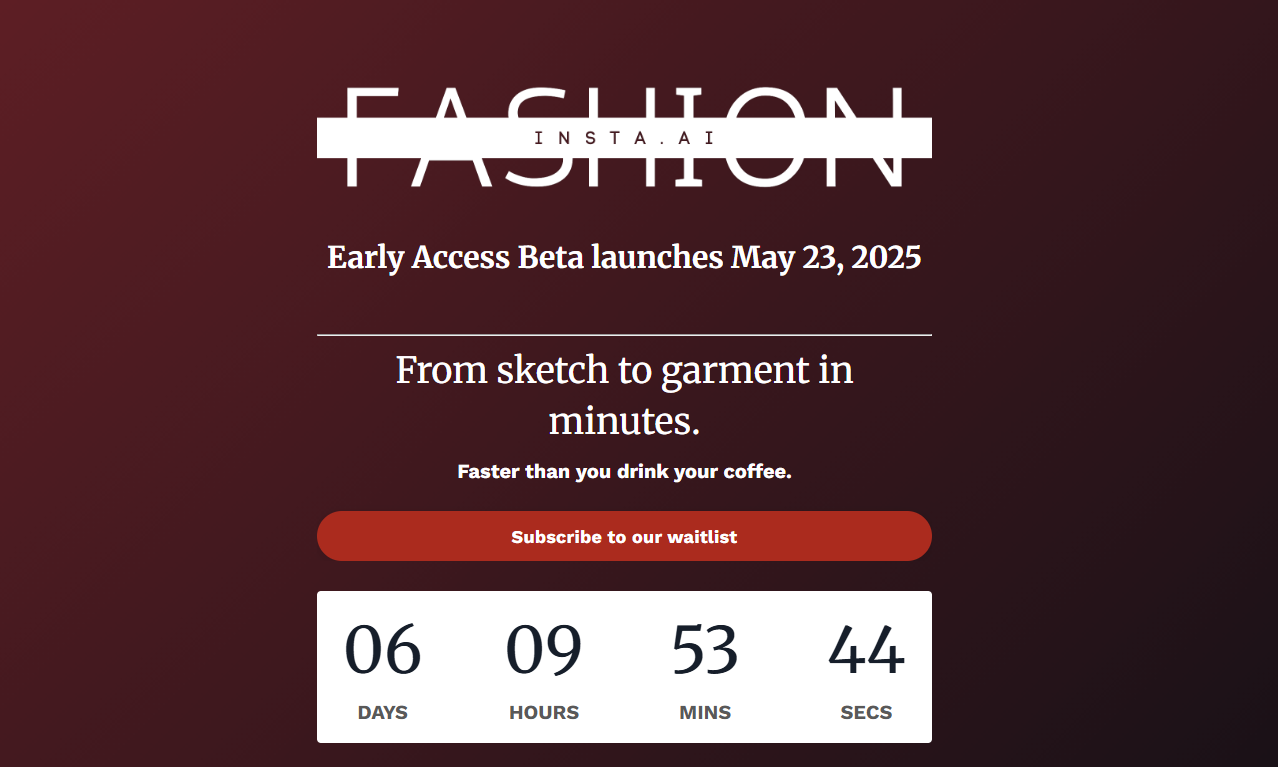
Join thousands of fashion professionals waiting for early access to the future of pattern making.
For more insights on the industry transformation, explore our analysis of why most AI fashion tools are entirely missing the point and discover the truth about AI in fashion design.
Further Reading:
→ McKinsey State of Fashion Report - Industry analysis of digital transformation and AI adoption trends
→ Fashion Institute of Technology: Digital Pattern Making - Educational resources on modern pattern making techniques and technology
→ CLO3D Integration Guide - Understanding 3D to pattern workflows in professional fashion design
→ Browzwear Virtual Fashion Technology - Advanced 3D fashion design and virtual sampling solutions
→ Adobe Creative Suite for Fashion - Traditional digital design tools and their role in modern fashion workflows
Check out fashionINSTA - your AI pattern intelligence system!
Want to try fashionINSTA?
Subscribe to our waitlist!
We hate SPAM. We will never sell your information, for any reason.
